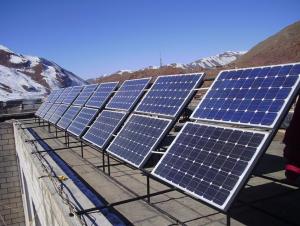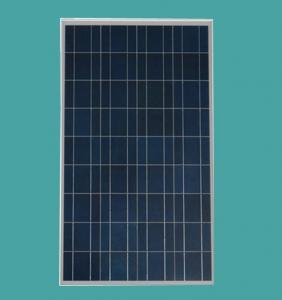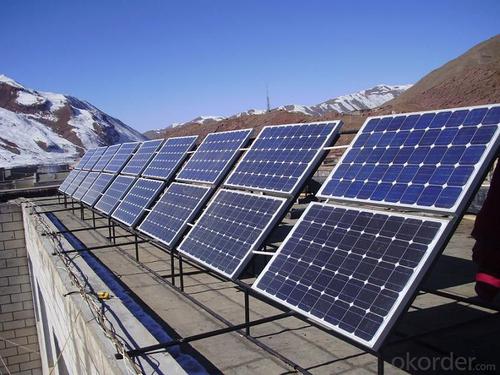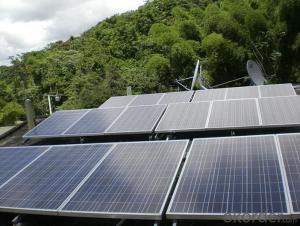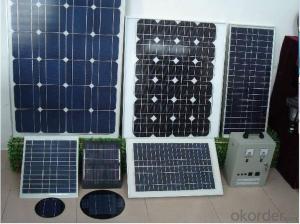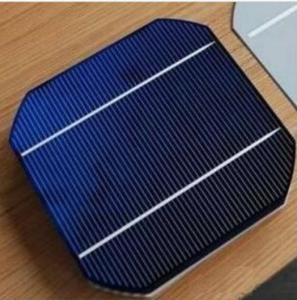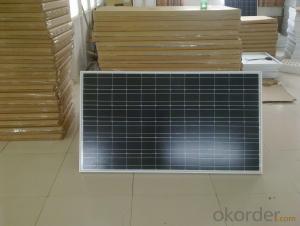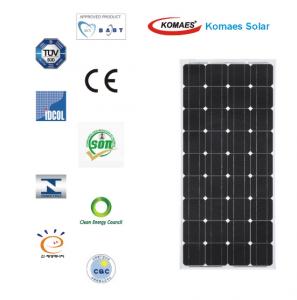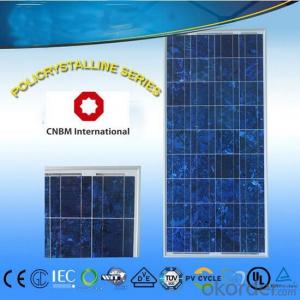Solar Cells Amazon - Monocrystalline Solar Cells for Solar Panels Energy Product System with TUV, MCS Certificate
- Loading Port:
- Tianjin
- Payment Terms:
- TT or LC
- Min Order Qty:
- 10 m²
- Supply Capability:
- 1000 m²/month
OKorder Service Pledge
OKorder Financial Service
You Might Also Like
Specifications
1.Solar panel energy system power from 165W-195W
2.100% TUV standard flash test
3.Certificate:TUV,UL,MCS
4.Quality Insurance
100% TUV standard flash test mono solar panel energy product system
1.What is 100% TUV standard flash test?
Flash test machine with TUV standard reference solar panel,all Propsolar Panel is tested with 100% TUV standard or standard higher than TUV standard
In the market,not all solar panel is real tested with TUV standard,Flash machine reference panel is not TUV standard,so the power is 2%-3% less than TUV standard.
2.Solar Panel Warranty
1)10 years limited manufacturing warranty
2)12 years for 90% of warranted minimum power
3)25 years for 80% of warranted minimum power
3.Solar Panel Electric Characteristics
CELL TYPE | 125 X 125 MONO SOLAR CELL | ||||||
ITEM | PS-M572165 | PS-M572170 | PS-M572175 | PS-M572180 | PS-M572185 | PS-M572190 | PS-M572195 |
Maximum Power(Wp) | 169.9 | 174.9 | 179.9 | 184.9 | 189.9 | 194.9 | 199.9 |
Open circuit Voltage (Voc) | 43.3 | 43.7 | 44.0 | 44.5 | 44.9 | 45.2 | 45.5 |
Short circuit Current (Isc) | 5.05 | 5.25 | 5.40 | 5.45 | 5.55 | 5.60 | 5.80 |
Maximum Power Voltage (Vm) | 35.3 | 35.5 | 35.6 | 36.0 | 36.3 | 36.5 | 36.7 |
Maximum Power Current (Im) | 4.67 | 4.79 | 4.92 | 5.00 | 5.10 | 5.21 | 5.31 |
Cell Efficiency [%] | 15.85 | 16.33 | 16.81 | 17.28 | 17.77 | 18.25 | 18.74 |
Module Efficiency [%] | 12.88 | 13.27 | 13.66 | 14.05 | 14.44 | 14.83 | 15.22 |
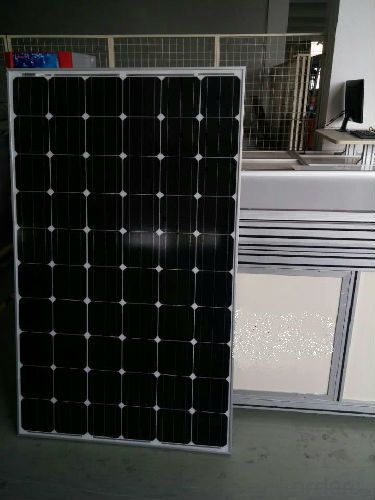
More Details:
Depending on construction, photovoltaic modules can produce electricity from a range of frequencies of light, but usually cannot cover the entire solar range (specifically, ultraviolet, infrared and low or diffused light). Hence, much of the incident sunlight energy is wasted by solar modules, and they can give far higher efficiencies if illuminated with monochromatic light. Therefore, another design concept is to split the light into different wavelength ranges and direct the beams onto different cells tuned to those ranges.[citation needed] This has been projected to be capable of raising efficiency by 50%. Scientists from Spectrolab, a subsidiary of Boeing, have reported development of multijunction solar cells with an efficiency of more than 40%, a new world record for solar photovoltaic cells.[3] The Spectrolab scientists also predict that concentrator solar cells could achieve efficiencies of more than 45% or even 50% in the future, with theoretical efficiencies being about 58% in cells with more than three junctions.
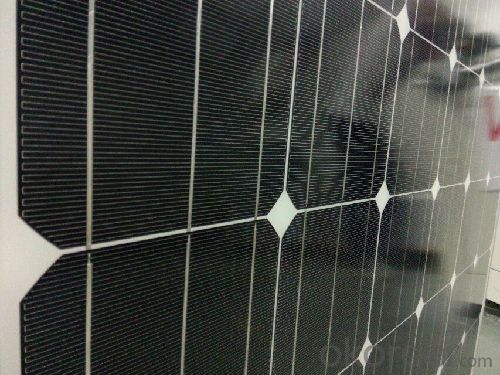
The life of the solar panels is determined by the Solar Energy Solar Cells, tempered glass, EVA, TPT and other materials, usually with better materials manufacturers panels made out of life can reach 25 years, but with the impact on the environment, solar cell board materials will change with time and aging. Normally used in 20 years of power will decay by 30%, it will be used in 25-year power attenuation of 70%.
Inspection and Maintenance of Solar Energy Solar Cells:
1. Check whether the damaged Solar Energy Solar Cells, to be promptly found and replaced.
2. Check the battery cables and the ground plate is good contact, without loss phenomenon.
3. Check the wiring at the combiner box if there is fever phenomenon.
4. Check the battery plate bracket loose and breakage.
5. Cleaning up around the panels shielding panels weeds.
6. Check whether the panel surface coverings.
7. Check the battery guano on the plate surface, and clean it if necessary.
8. The cleanliness of the panels were identified.
9. Windy weather to deal with solar panels and frame to conduct audits.
10. Snow days to respond in a timely manner to clean up the panel, the panel surface to avoid the frozen snow.
11. Heavy rain should check all waterproof seal is good, whether the water leakage.
12. Check if there are animals into the power station to the battery plate damage.
13. Hail response panel surface to conduct audits.
14. The battery plate temperature is detected, and the ambient temperature is compared for analysis.
15. Check it out on the issues to be addressed promptly analyzed and summarized.
16. To do detailed records of each inspection, in order to analyze later.
17. Summary records for analysis and archiving.
- Q: Can solar cells be used in emergency lighting?
- Yes, solar cells can be used in emergency lighting. Solar cells convert sunlight into electricity, which can then be stored in batteries for use during emergencies or power outages. This makes solar-powered emergency lighting a reliable and sustainable option.
- Q: How to define the poly solar cells as the A Grade one?
- If the poly solar cells is high module conversion efficiency, through superior manufacturing technology Guaranteed -1% to +3%, it is very possibily the A grade.
- Q: What is the role of solar cells in powering streetlights?
- Solar cells play a crucial role in powering streetlights by converting sunlight into electrical energy, which is then used to illuminate the streetlights. They provide a sustainable and renewable source of power, reducing dependence on the electrical grid and minimizing carbon emissions. Moreover, solar cells enable streetlights to operate efficiently, even in remote or off-grid locations, making them an environmentally friendly and cost-effective solution for outdoor lighting.
- Q: Can solar cells be used for powering security systems?
- Yes, solar cells can be used for powering security systems. Solar cells convert sunlight into electricity, which can be used to power various devices including security systems. This renewable energy source is reliable, cost-effective, and environmentally friendly, making it a suitable option for powering security systems in remote locations or areas with limited access to electricity grids.
- Q: How do solar cells perform in high altitude locations?
- Solar cells tend to perform better in high altitude locations due to the thinner atmosphere. With less air to scatter and absorb sunlight, solar cells can capture more solar radiation, resulting in increased energy production. Additionally, the lower temperatures at higher altitudes can also enhance the efficiency of solar cells.
- Q: What is the working principle of a solar cell?
- The solar cell works in the way that use the sunshine as the resources to generate the power for us to use.
- Q: Can solar cells be used on road surfaces?
- Yes, solar cells can be used on road surfaces. Solar roadways or solar panels embedded within road surfaces are being developed to generate clean and renewable energy. These solar cells can capture sunlight and convert it into electricity, which can be used to power streetlights, traffic signals, or even charge electric vehicles. However, the technology is still in its early stages and faces practical challenges such as durability and cost-effectiveness.
- Q: What is the role of solar cells in powering off-grid cabins?
- The role of solar cells in powering off-grid cabins is to harness energy from the sun and convert it into electricity. These cells, also known as photovoltaic cells, absorb sunlight and generate a direct current (DC), which is then converted into alternating current (AC) through an inverter. This AC power is used to operate appliances, lighting, and other electrical devices in off-grid cabins, providing a sustainable and renewable source of energy without the need for a traditional power grid connection.
- Q: Can solar cells be used on vehicles other than cars?
- Yes, solar cells can be used on vehicles other than cars. Solar cells can be integrated into various types of vehicles including buses, motorcycles, bicycles, boats, and even spacecraft. The energy generated by solar cells can be used to power the vehicle's electrical systems, reduce reliance on fossil fuels, and contribute to a more sustainable transportation infrastructure.
- Q: Can solar cells be used in off-grid cabins or cottages?
- Yes, solar cells can definitely be used in off-grid cabins or cottages. Solar cells, also known as photovoltaic cells, convert sunlight into electricity, making them an excellent renewable energy source for remote locations. By harnessing the power of the sun, solar cells can generate electricity to power lights, appliances, and other electrical devices in off-grid cabins or cottages, allowing for a sustainable and independent energy solution.
Send your message to us
Solar Cells Amazon - Monocrystalline Solar Cells for Solar Panels Energy Product System with TUV, MCS Certificate
- Loading Port:
- Tianjin
- Payment Terms:
- TT or LC
- Min Order Qty:
- 10 m²
- Supply Capability:
- 1000 m²/month
OKorder Service Pledge
OKorder Financial Service
Similar products
Hot products
Hot Searches
Related keywords
